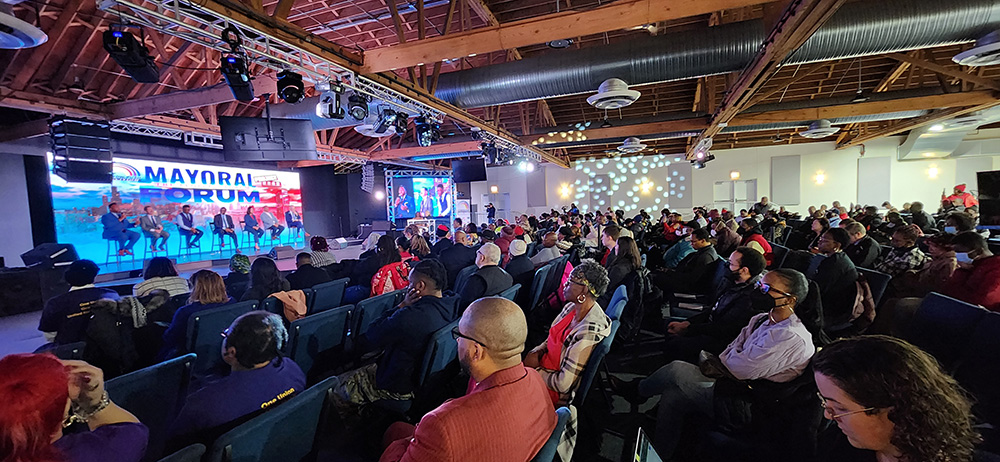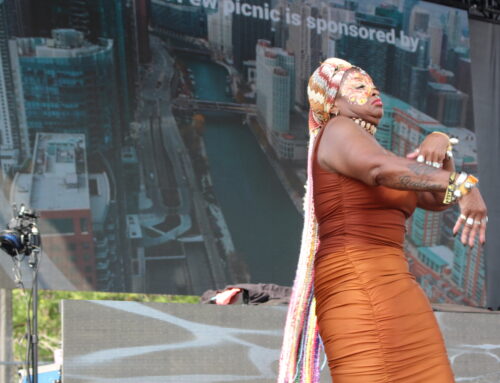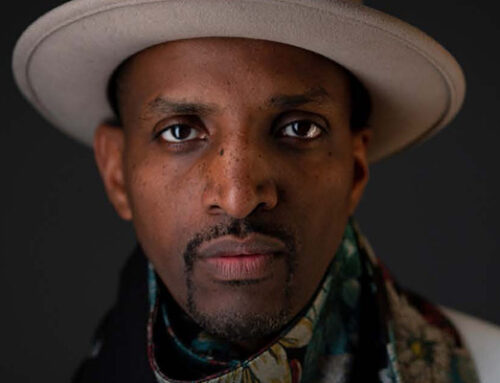By Robert T. Starks –

Rainbow PUSH Mayoral Candidates Forum
Photo Credit:
Tuesday, February 28th, 2023, is Chicago Municipal Election Day. The election ballot will include the choice of candidates for Mayor, City Clerk, City Treasurer, Alderpersons (one in all fifty wards) and three persons to serve on the Chicago Police Council in each of the 22 Chicago Police Department Districts in the city. The candidates for Mayor, City Clerk, and Treasurer who receive a majority of the votes cast for each office will be declared the winner to serve for four years. If no candidates receives a majority of the votes in the February 28th election, the two candidates’ names that received the highest and second highest number of votes in the February 28th election will appear on the ballot in the runoff election to be held on April 4, 2023. The same rules will apply to the election of the 50 Alderpersons, i.e., one person will be elected in each ward. If there is not a majority winner, the two candidates with the highest number of votes will appear on the April 4th runoff.
The newest addition to the Municipal Election ballot is that of members of the Police District Council. Three candidates will be elected to each of the 22 Chicago Police Department Districts in the city. The Board of Election Statue states “The candidates in each Police District receiving the greatest, second greatest, and third greatest number of votes shall be elected and shall take office on the first Tuesday after the first Monday in May following their election.”
The 2023 Candidates for Mayor of Chicago are as follows:
State Rep. Kam Buckner, U.S Rep. Jesus “Chuy” Garcia, Mayor Lori Lightfoot, Alderwoman Sophia King, Alderman Roderick Sawyer, Activist Ja’Mal Green, Cook County Commissioner Brandon Johnson, former Chicago Public Schools CEO Paul Vallas, and businessman Willie Wilson.
Thus, Chicago voters will select a mayor from an African American Incumbent Mayor Lori Lightfoot who is seeking a second term and six additional African American candidates including two alderpersons, one state representative, one county commissioner, one activist and a millionaire businessman. The last two candidates are a Hispanic U.S. Congressman and a White former CPS CEO. This lineup represents the three majority racial groups in the city. African American voters have seemingly the advantage of a larger range of candidates to choose from. However, if racial and ethnic voting patterns of the past hold, the clear disadvantage for these voters is that they will divide their votes among seven candidates.
Chicago voters are destined to witness a repeat mayoral runoff for mayor on April 4th.
ELECTION IMPORTANCE
The Municipal Election is crucial to the future of the city. The character, preparedness and dedication to progressive governance are necessary traits of elected officials in order to move this city forward given the plethora of problems this city faces now and will face in the future.
Equally important is the need for a well informed and eager voting citizenry that will exceed the most recent voter turnout of 30 to 35 percent on election day. The voter turnout of all eligible young, male, and progressive voters is necessary to move this city into the positive direction that is needed.
The major interrelated problems facing the city are as follows:
- Crime and violence
- A Defunct Education System
- Major economic and governmental disinvestment in Black communities
These three areas of concern are inexplicitly bound together by a history of neglect by this city government and private businesses. This is consistent neglect that is the result of endemic racism, machine politics and weak Black community leadership.
CRIME AND VIOLENCE
No one can deny the need for citizen safety in every section of this city. The City of Chicago is undeniably one of the most violent and crime ridden cities in this nation. The highest rate of crime, violence, and arrests, as measured by the Chicago Police Department, The State of Illinois and the Federal government, occurs on the south and west sides of the city in Black communities. Unfortunately, almost 75 percent of the crimes, shootings and homicides committed in these areas are never solved. At the same time the massive crimes committed by government and corporate entities are routinely overlooked and or dismissed.
The highest crime areas are on the West side — Garfield Park, North Lawndale, and Austin. These communities have experienced a slight decrease in shootings and homicides in 2022, however, residents still do not feel totally safe. Similarly, South Side residents have witnessed an increase in crime and violence throughout the 2000’s. This is especially reflected in the neighborhoods of Englewood, Roseland, and South Shore. The mayoral candidates have all pitched their campaign messages as if crime is the only issue that voters are concerned about. While voters across the city are seriously concerned about crime and their safety, they are also looking to candidates to outline solutions to other critical city problems.
The root causes of the street crime are poverty, disinvestment in poor neighborhoods, the overabundance of gun and drugs in these neighborhoods and the failure of Chicago Public Schools to deliver quality education to residents in poor and African American neighborhoods.
HOUSING
Affordable housing is in high demand in Chicago but scarce and almost nonexistent. The availability of affordable housing is especially apparent on the South and West sides of the city. The poorest people in Chicago live on the South and West sides. Many of the residents are homeless. One of the largest segments of the poor population in the Black community is homeless children who struggle with emotional issues that affect them greatly.
Since home ownership is the foundation of wealth building and economic stability for most Americans, Black families continue to suffer from the enduring racist traditions of mortgage exclusion. Black families in Chicago have suffered the inability to own real estate because of the federal government’s explicitly racist redlining policies that led to Black Chicagoans having to resort to predatory housing contract buying. Black residents on the South and West sides of the city have had their neighborhoods redlined. Redlines were drawn around the boundaries of Black neighborhoods to indicate that these were areas that excluded Black homebuyers from access to mortgages, as well as major corporate insurance companies that excluded sales to Blacks. These practices compounded the ability of Black families to move out of poverty. Ta-Nehisi Coates states, “Housing determines access to transportation, green spaces, decent schools, decent food, decent jobs, and decent services”. Thus, from the Great Migration of the early 1900’s, to present Black families on the South and West sides of Chicago have suffered from the ravages of intergenerational poverty, which is one of the major contributors to crime and violence.
EDUCATION
The gross failures of the Chicago Public School system to provide quality education to Black students is a major contributor to the rise in crime and violence in Black communities. The Chicago Public School system has never been totally fair and responsive to Black communities.
These factors range from its resistance to the call for integration of the public schools, underfunding majority Black schools, discrimination in the hiring of Black teachers and administrators, the closing of 50 majority Black schools and the elimination of the truancy Program. The elimination of truancy officers by Mayor Richard M. Daley in 1992 and the failure of subsequent mayors to reinstate this essential function and personnel have greatly contributed to the overall number of young people who engage in street crime and violence. Truant students, i.e., are those who are absent from school for no valid cause for one or more days. Chronic truants are dropouts or “pushed outs” from the public schools. Most of these truant students live in poverty-stricken neighborhoods on the South and West sides of the city. A sound estimate is that 90 percent of those young people who are engaging in crime and violence are dropouts and “pushed outs.”
Truancy from school is a major risk factor and truant students cannot be assisted because of the lack of truant officers who once tracked their school attendance and placed them back in the classrooms. The lack of truant officers and the systematic dumping of drugs and guns into Black neighborhoods are examples of identified issues largely overlooked by city, state, and federal government agencies. These failures to intervene or address youth issues are predictors of youth negative pathways that have nearly totally devastated many Black communities. Criminal behavior on the part of these young people is now moving outside of their neighborhoods into the downtown business district and the surrounding residential areas.
ECONOMIC AND GOVERNMENTAL DISINVESTMENT
The chronic disinvestment in this city’s Black communities exacerbates the problems of education, crime and violence, and the lack of access to affordable housing. Disinvestment results in food deserts, rotting infrastructure, and the lack of adequate public transportation, affordable housing and access to jobs. Disinvestment in Black communities is not a new phenomenon. This racist practice that is nationwide.
When a neighborhood changes from White to Black, government, business, and social investment is immediately withdrawn. Conversely, when a Black neighborhood is in the process of gentrification and White families return, those same economic and social investments return. Most Black families are unable to afford the cost of living in gentrified neighborhoods. One of the examples of the results of gentrification is the rapid movement of white middle class professionals into new and reconstructed housing west of the loop along the Monroe, Madison, and Washington Avenues. On the South side gentrification is rapidly moving south along State, Wabash, and Michigan Avenues. The Woodlawn neighborhood is presently undergoing gentrification as a result of the oncoming Obama Center. Long time Woodlawn residents will be pushed out by the lack of affordable housing and higher property taxes for homeowners.
MUNICIPAL GOVERNMENT CANDIDATES ON THE FEBRUARY 28TH BALLOT
There are 9 candidates for mayor who will appear on the ballot. The immediate concerns of Black voters are: 1.) Public safety, good schools, government and business investments that are affordable for low- and middle-income families; 2.) The need for police reform that will put an end to police brutality, police murders of innocent Blacks, and the addition of Black policemen in black neighborhoods; 3.) The dangerous lead in the water pipes; 4.) The lack of access to mental health and general health clinics; 5.) The lack of access to jobs; 6.) Traffic gridlock; 7.) The lack of Black participation in city and regional planning; 8.) The glaring inequalities in the hiring of Blacks by the Police and Fire Departments; and 9.) The racial inequalities in municipal and county taxes.
Thus, those candidates who will address these problems and issues are the ones who will also command the greatest attention of Black voters. Unfortunately, most of the candidates have chosen to propagate the language and gospel of Presidential candidate Richard Nixon’s “Law and Order” mantra, which was a dog whistle to White voters that Blacks were the majority persons engaging in criminal behavior, and they must be stopped and put behind bars. In this scenario, cause is attributed to the innate inability of Blacks to constrain their tendency to commit crime. This preachment on the part of mayoral candidates is gospel to many White voters who refuse to consider the real causes of crime listed above. Further, this approach also overlooks the ingrained Chicago Police Department’s racist practices of no-knock raids, excessive force, chokeholds and murder of innocent citizens.
Lastly, many of these Municipal candidates for office have forgotten the election strategy of Mayor Harold Washington who placed hundreds of “foot soldiers” out in the field to carry his message to the citizens without relying totally on television, radio, and mailings. The winning strategy is to employ them all.





Leave A Comment